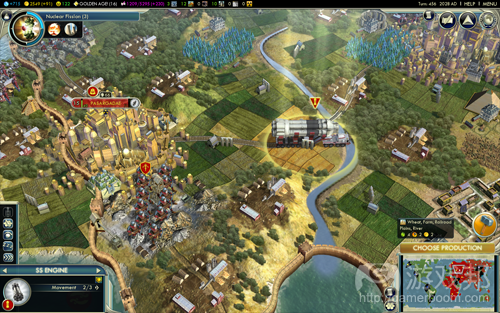阐述非对称模式产生的效果及其融入难度
作者:Jon Shafer
对设计师而言,在玩家之间设置非对称模式是最佳且最具难度的方式。它不仅能为游戏体验增添趣味,而且完美实现这种做法能够提高重玩价值。以下我们将详细阐述非对称模式产生的效果,以及为何在游戏中融入这种模式颇具难度。
非对称模式的作用
如果游戏能为玩家提供更多新型体验,那便意味着该作具有更多重玩价值。而扩大体验类型的一种最佳方式便是采用非对称模式。在《文明》初作中,所有文明完全相同,因此玩家只能体验这种默认模式。而《文明5》不再出现这种情况,其设计团队旨在设置值得体验的独特派系,但这种多样性并没有覆盖核心机制。
同时,其它游戏也支持这种做法,并制作出几乎不具重复性的关卡。经典战略游戏《Master of Magic》中的每个派系既不相同也不平衡。但大多数玩家对此不屑一顾,因为这是一款有趣且“破坏性”地使用魔法的游戏。如果该作呈现出完美的平衡模式,那它可能会丧失所有迷人部分。
除了可以保持游戏进程难度,非对称模式还能提高战略决策。如果游戏各个方面的玩法保持一致,那么同一情况下的最佳反应则会如出一辙。在《文明1》中,如果玩家发现自己紧挨着某个虚弱的敌人,那么其正确反应基本会是采取进攻。一旦玩家发现这种现象,那么曾经存在的任何真正策略便会通通消失(可能有人认为这是平衡模式中的主要问题,但毫无疑问,非对称模式至少能够转移这类问题!)。
在精致的机制设计上,非对称模式能赋予玩家特殊“感觉”。《星际争霸》系列中的三个种族从视觉上看存在明显差异,但它们的独特机制同样重要。虫族和人族能够维持自己的独特外观,如果它们属于具有相同技能的同种单位,只是外表色彩存在差异,那就无法达到《星际争霸》的效果。虫族是一个有机群体,它们数目众多,且具备独特性能(游戏邦注:比如能在地里挖洞)。其形象兼非对称特征是促使其成为所有游戏中最深刻派系的原因。
采用非对称模式的难度
作为设计师,在复杂战略游戏中我应解决的一个最棘手问题是找到在不破坏当前元素的情况下,融合非对称模式的方式。移动越少部分意味着越容易保证游戏的完美节奏与平衡。当非对称融为游戏一部分时更能取得双重效果,因为这意味着游戏各个方面的玩法本质上存在些许差异。
去年我与David Sirlin就非对称模式的重要性与适当性进行过深入探讨。我个人认为,一款设计精良且具有一定复杂性的游戏无需这种因素,而且可能会造成相反效果。但David辩解道,非对称模式能为所有游戏润色,只是正确实现难度极大。
当然,我可以明白David的立场,虽然我仍相信由于现实世界的限制,有些游戏并不适合融入非对称模式。如果《文明》中的每个派系同《星际争霸》的种族一样各不相同,那么前者的最终结局无疑会是一片混乱。当然玩家喜爱附加类型,而不少作品可能会因糟糕的节奏与平衡模式走向末日。
当然,节奏与平衡相当重要,但我更担忧的是,复杂战略游戏中的非对称模式可能会将玩家封闭在明确且无趣的游戏套路中。“哦,所以蒙古人是好战一族?既然如此,为何我还要操心其它事宜?”
如今,制作出从始至终贯穿着棘手战略决策的游戏是件难事。如果你打算设置独特派系,那只会增加自己的工作量。因此,你已平衡文化游戏与军事游戏,并保证它们的趣味性。你甚至实现了装备切换的可能性,并考虑了最佳选项。那么,现在你应确保这种模式适合好战的蒙古人。以及海上日本人和勤奋的德国人。
许多游戏并不会呈现出逐渐复杂的非对称模式,对它们而言,大量非对称模式可能具有一定意义。但每个项目在时间与资源上都有一定限制。你是想要一款更加复杂的游戏,还是更不对称的作品呢?最终,设计师应认识到,这种决定会影响到游戏制作的方方面面。(本文为游戏邦/gamerboom.com编译,拒绝任何不保留版权的转载,如需转载请联系:游戏邦)
Asymmetry
by Jon Shafer
The following blog was, unless otherwise noted, independently written by a member of Gamasutra’s game development community. The thoughts and opinions expressed here are not necessarily those of Gamasutra or its parent company.
Asymmetry between players is one of the designer’s best – and most challenging – tools. Not only does it spice up the experience of playing the game, when implemented well it also greatly enhances replayability. Let’s look in detail at the impact it can have, along with why it’s sometimes so hard to incorporate.
What Does Asymmetry Add?
The more new experiences a game can provide players the more replayable it is. One of the best ways to expand that variety is with asymmetric factions. In the original Civilization all of the civs were identical, so outside of one’s imagination there was no reason to ever play anyone but the default. In Civilization 5 this is no longer the case, and the goal of the design team was to have factions that were unique enough to all be worth playing, but not so much so that these differences stole the show from the core mechanics.
Other games fully embrace asymmetry, and almost make experiencing the unique aspects of each side the game. In the old strategy game Master of Magic, each faction was very different – and also fairly imbalanced. But most players shrugged this off because it’s a game about using magic in interesting and “fun” (read: broken) ways. Had Master of Magic been perfectly balanced it likely would have lost much of what made it charming.
Aside from just keeping a game on people’s hard drives longer, asymmetry can also enhance strategic decisions. If all sides play the same way, then the optimal response in an identical situation will always be the same. In Civilization 1, if the player finds him or herself next to a weak, unfriendly rival the right response is basically always to build an invasion force and attack. Once players have figured this out, any true strategy that had once existed vanishes. (One might say that this is mainly an issue of balancing, but there’s no doubt that asymmetry at least helps deflect problems like this!)
While it’s not chunky mechanical design, “feel” is another area where asymmetry can pay large dividends. The three races in Blizzard’s Starcraft series are obviously visually distinct, but their unique mechanics are just as important. The Zerg and Terrans could maintain their excellent art direction, but if they had basically the same units with the same abilities, only with different coats of paint, it would no longer feel like Starcraft. The Zerg are an organic swarm – their units should be more numerous and should have unique abilities like burrowing out of the ground. Their art plus their asymmetric traits is what makes them among the most memorable factions in all of gaming.
The Challenges of Utilizing Asymmetry
One of the toughest problems for me to tackle as a designer of complex strategy titles is finding ways to incorporate asymmetry without breaking what’s already in-place. The fewer moving parts a design has the easier it is to ensure good pacing and balance. This is doubly true when asymmetry is a factor, because it means each side is essentially playing its own slightly-different version of the game.
Last year I had a great discussion with the brilliant David Sirlin about the value and appropriateness of asymmetry. I felt that a sufficiently well-designed game of a certain complexity didn’t need it, and it might in fact be harmful. But David argued that asymmetry makes every game better – it’s just that implementing it properly can be immensely difficult.
I can certainly see David’s case, although I do still believe that there are some games where incorporating asymmetry is unfeasible given the constraints of the real world. If every faction in a Civilization title were as unique as the races in Starcraft, the end result would be an absolutely broken mess. Certainly players would love the extra variety, but a great many would be turned off by the inevitably abysmal pacing and balance. (Heck, some people would argue that’s already the case for the Civ games – well, if you’re one of those people just imagine if it were ten times worse!)
Pacing and balance are certainly important, but my bigger concern with asymmetry in complex strategy games is its potential to lock players into completely obvious and uninteresting paths. “Oh, so the Mongols are the warmonger race? Okay, why should I even bother doing anything else?”
It’s already a tall order to produce a game filled with tough strategic decisions from start to finish. If you have very unique factions then you’re basically multiplying your workload that many more times. Okay, so you have the culture game and the military game balanced with one another and they’re both interesting. You’ve even made it so that switching gears is possible and you always have to consider the best option available. Alright, now make sure that’s true for the warlike Mongols. And the maritime Japanese. And the industrious Germans. Yikes!
Many games aren’t faced with a spiraling complexity of this sort, and for those a great deal of asymmetry probably makes sense. But every project has a limited amount of time and resources. Do you want a more complex game, or a more asymmetric game? Ultimately the designer has to make that call knowing that this decision shapes the direction for every facet of the game.(source:gamasutra)
上一篇:深度分析游戏内部的经济设置









































